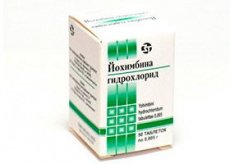Medical expert of the article
New publications
Preparations
Yohimbine hydrochloride
Last reviewed: 23.04.2024

All iLive content is medically reviewed or fact checked to ensure as much factual accuracy as possible.
We have strict sourcing guidelines and only link to reputable media sites, academic research institutions and, whenever possible, medically peer reviewed studies. Note that the numbers in parentheses ([1], [2], etc.) are clickable links to these studies.
If you feel that any of our content is inaccurate, out-of-date, or otherwise questionable, please select it and press Ctrl + Enter.

Drug for the normalization of erectile function - Yohimbine hydrochloride - is used for various conditions and pathologies, which are accompanied by erectile dysfunction.
Pharmacodynamics
The substance yohimbine is an effective tool for potentiation and is an alkaloid drug obtained from the bark of an African woody plant.
The principle of action of Yohimbine hydrochloride is explained by the selective blocking of α²-adrenergic receptors. The drug increases central adrenaline metabolism, activating adrenergic nerve cells in the central nervous system, which provokes the development of psychostimulant action and aggravation of the reaction. There is an opinion that the drug has an effect on serotoninergic, dopaminergic, cholinergic system of nervous innervation.
It has been proven by experience that Yohimbine hydrochloride stimulates sexual attraction and stabilizes the sexual function lost due to stressful situations, restores a frustrated erection.
The therapeutic effect is explained by the effect of the drug on the central nervous system. Perhaps, the effect is also associated with the expansion of the vessels of the reproductive organ and the improvement of blood circulation in the tissues.
Periodic inhibition of the efficacy of Yohimbine hydrochloride during the second to third week of treatment may be associated with the accumulation of the active product 11-hydroxy yohimbine.
Pharmacokinetics
Yohimbine hydrochloride is fully absorbed into the digestive system for 60 minutes. The limiting content of the substance in the bloodstream is observed after 45-75 minutes.
The first passage of the drug is through the liver. The active substance does not accumulate in the tissues and body fluids.
Distribution in tissues is always uniform. In the serum, 82% of the active ingredient comes into contact with the protein, and only a small amount of the drug is found in the intercellular fluid.
Metabolic conversion of Yohimbine hydrochloride occurs in the liver and beyond. Two types of metabolites have been discovered - 11-hydroxy yohimbine is more active, and less active is 10-hydroxy yohimbine.
The half-life of a single dose of the drug is from 25 minutes to 2 ½ hours. With prolonged treatment, Yohimbine hydrochloride is excreted over a period of 60 minutes to 8 hours.
 [10],
[10],
Dosing and administration
Yohimbine hydrochloride tablets are taken with food and a sufficient amount of liquid. Chew and grind the tablet can not.
The optimal amount of the drug per day - from one to six tablets, divided into 1-3 doses.
Usually, the doctor selects the dosage separately for each patient. The initial dose can be half the tablet three times a day, with a gradual increase to 1-2 tablets three times a day.
In some cases, the effect of treatment may be delayed and develop only after 14-20 days from the start of taking Yohimbine hydrochloride.
The total duration of therapy depends on many individual causes and can range from several weeks to one month.
Use Yohimbine hydrochloride during pregnancy
The drug Yohimbine hydrochloride is prescribed only to men.
Side effects Yohimbine hydrochloride
Sometimes the administration of Yohimbine hydrochloride may be accompanied by undesirable reactions, namely:
- heart palpitations;
- pain in the head, sleep disorders, irritability, trembling in the hands, increased sweating, a sense of anxiety;
- dyspepsia;
- hyperemia of the skin;
- increased blood pressure;
- a decrease in the daily amount of urine, prolonged erection without sexual arousal;
- an allergy.
Overdose
Admission of excess amounts of Yohimbine hydrochloride is manifested as signs of intoxication, which are expressed in general weakness, paresthesia, memory disorders and motor activity, headache, hypertension, a sense of fear and anxiety. Additionally, such signs can develop:
- increased heart rate;
- dizziness;
- increased norepinephrine content in the bloodstream;
- dyspeptic disorders;
- salivation;
- lacrimation;
- hyperhidrosis.
After 4 hours after taking a large amount of Yohimbine hydrochloride, there can be pain behind the sternum, which continues to bother for several hours.
As a treatment, the drug is canceled, the stomach is washed, and sorbent preparations are taken (activated charcoal).
Antidote can serve as a drug Clonidine, which neutralizes the psychic manifestations of an overdose. It is prescribed in an amount of 0.1-0.2 mg orally. It is possible to repeatedly apply Clonidine in the amount of 0.1 mg every 60 minutes, to stabilize the work of the heart and to alleviate the patient's condition.
Interactions with other drugs
Clonidine can be prescribed only with an overdose of Yohimbine hydrochloride. In other cases, these drugs neutralize the effect of each other.
Yohimbine hydrochloride can affect the effectiveness of drugs that prevent high blood pressure.
Yohimbine hydrochloride improves the effectiveness of antidepressants and increases the likelihood of developing side effects, but it can reduce the effect of tranquilizers.
The drug Clomipramine increases the content of yohimbine in the bloodstream.
There is a small amount of lactose in the composition of Yohimbine hydrochloride, and this should be taken into account when prescribing the drug to people with intolerance to galactose, lactase deficiency, and also to the pathology of glucose-galactose malabsorption.
Attention!
To simplify the perception of information, this instruction for use of the drug "Yohimbine hydrochloride" translated and presented in a special form on the basis of the official instructions for medical use of the drug. Before use read the annotation that came directly to medicines.
Description provided for informational purposes and is not a guide to self-healing. The need for this drug, the purpose of the treatment regimen, methods and dose of the drug is determined solely by the attending physician. Self-medication is dangerous for your health.

